Public Opinion Tracker Deep Dive: Teen Perspectives
The process toward reopening schools appears to be reaching a turning point.
The Department of Education’s National Safe School Reopening Summit, broadcast March 24, discussed strategies and updated CDC recommendations for schools to reopen safely. With the Institute for Education Sciences’ (IES) first monthly school survey released in March, we have much greater clarity about how public elementary schools are operating at this point in the school year. We now have the most comprehensive view about what proportions of these schools are offering some form of hybrid education and how prevalent live instruction is for online students.
IES only surveyed schools serving fourth grade and eighth grade students, however. High schools are not currently part of the IES sample design and protocol, so we still have a dearth of information about how teens are doing right now.
Common Sense Media and YouthTruth have commissioned surveys of teenagers since the start of the pandemic. Those projects and findings have shed light on a range of topics, such as how they are currently learning; feelings of stress, anxiety, and other social-emotional questions; use of digital media for adapting to circumstances or coping mechanisms; and post-secondary planning. The most recent of those surveys completed fieldwork in December.
Our new survey of teenagers, conducted by Morning Consult, should further help fill some of the information gap. We surveyed a nationally representative sample of 1,000 teens aged 13-17 from February 22-24, 2021. As of now, this is the most recent survey snapshot of America’s teens. We asked about their perspectives on the COVID-19 pandemic, how they are learning, and how they feel they are doing relative to this point last year. As always, we’ve made the full results and crosstabs available here, and we are sharing several important highlights below.
In a nutshell: A substantial majority of teens remain concerned about the COVID-19 pandemic, and more teens reported worse mental health and personal wellbeing than the last time we surveyed this demographic back in August 2020. Students learning in-person are more positive about their education and personal wellbeing than their hybrid and online peers, but a substantial share of them think their schools could better implement COVID-19 safety measures. Students at least partially online say they have greater resource access now than they did at the beginning of the school year. However, some form of hybrid education appears to be popular among teens. Teens are noticeably less aware of education reform compared to other social issues and current events.
1. Teens report their health and happiness dropping since the beginning of the pandemic. Compared to last March, majorities of teens say their stress (63%), motivation (54%), anxiety (53%), and mental health (51%) have worsened. Teens also are more likely to say their happiness, friendships, family finances, and physical health have worsened rather than improved.Teens learning at least partially online were three times as likely to report declining mental health compared to in-person students. Females and white students also were more likely to report declining mental health.
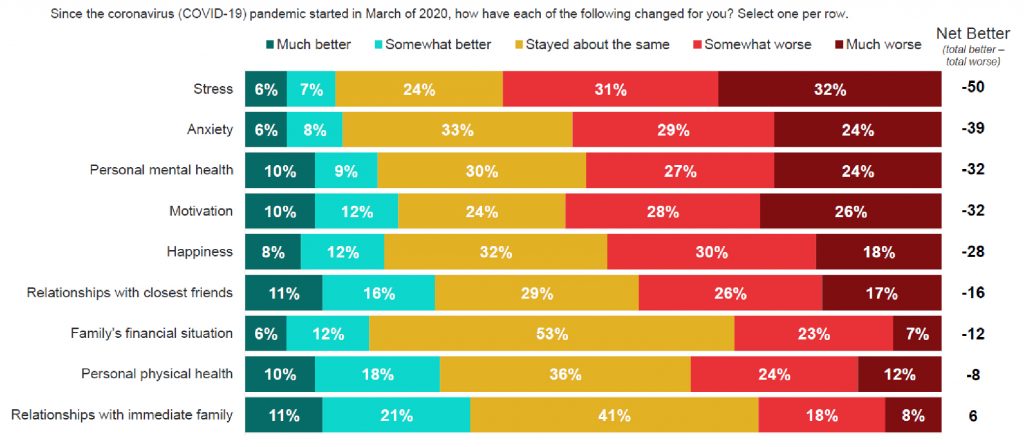
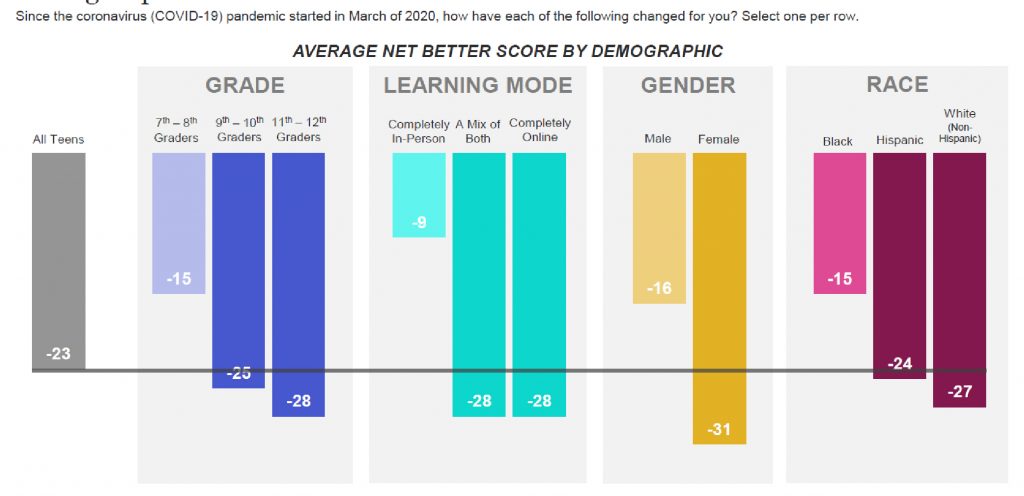
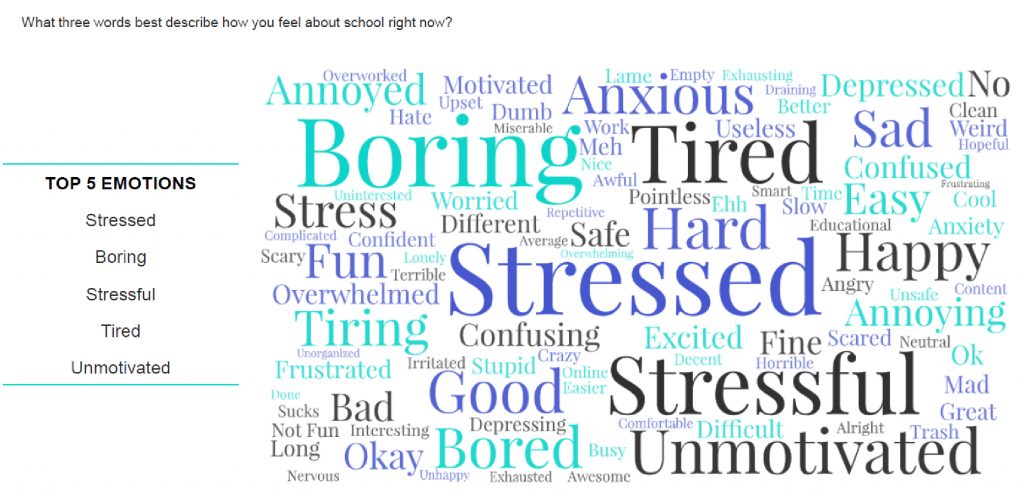
2. Concern about the pandemic remains high, but lower than it was at the beginning of the school year. The total share of teens reporting at least some level of concern for about COVID-19 decreased from 81 percent to 72 percent from August to March. The decrease in those feeling “very concerned” composed most of that decline, dropping from 39 percent to 31 percent. Teens indicating they are not that concerned or not concerned at all increased by four percentage points and five percentage points, respectively.
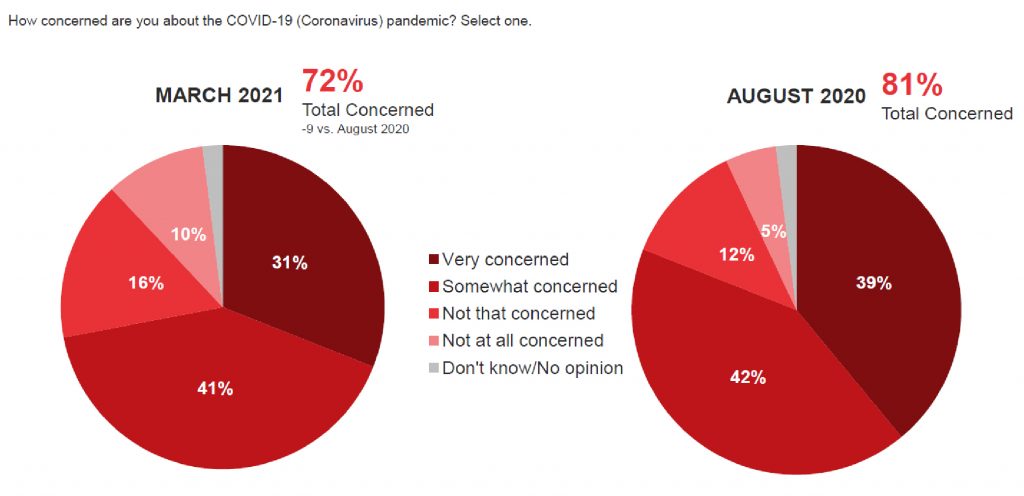
3. Teens attending school in-person are more positive about their education this year than those partially or completely online. Of the 16 percent of teens indicating their education is currently entirely in-person, 80 percent of them say school is going at least somewhat well. Though lower than their in-person peers, significant majorities of other teens in hybrid or completely online education also report their education is going well at 62% and 63%, respectively. Additionally, the share of in-person teens strongly positive about their education experience doubles that of completely online students.
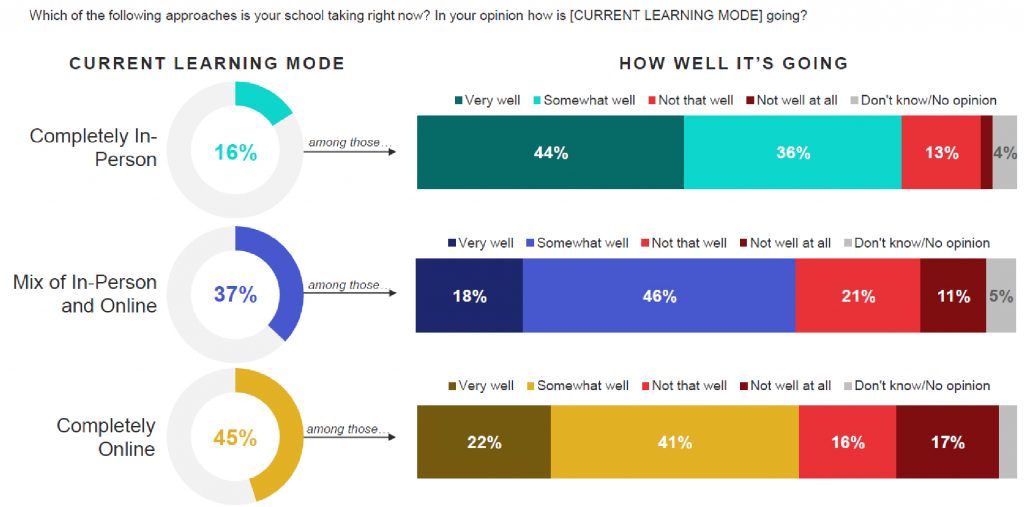
- Teens attending school at least partially in-person suggest their schools have been most successful implementing mask-wearing policies and least successful implementing social distancing policies. Of the six anti-COVID safety measures presented to teens attending school in-person at least partially, mask-wearing was the only policy that a majority of teens said their schools were implementing well. Frequent cleaning and capping classroom sizes had positive ratings outnumber negative ratings. Teens were more negative about their schools implementing social distancing policies, including the recommendation that people keep six feet of distance from each other and that schools install physical barriers where distance cannot be kept. Notably, though, teens most commonly rated their schools “average” in implementing COVID-19 policies besides mask-wearing
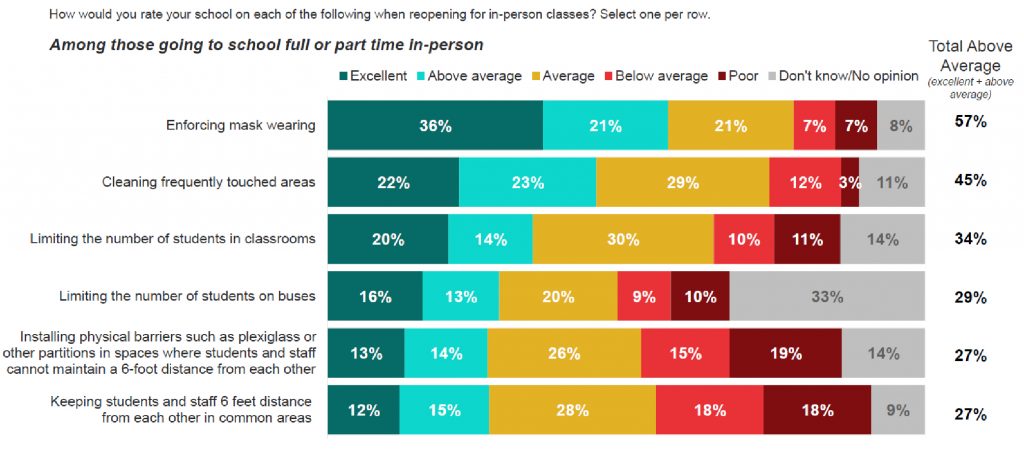
- Teens who are learning at least partially online report having more resources than they did at the beginning of the school year. Access to the internet, computers or similar devices for schoolwork, teachers, and a quiet place for studying all improved by at least 9 percentage points compared to the beginning of the school year. Additionally, the share of teens learning online reporting they had access to parents or guardians for help with school rose slightly since August.
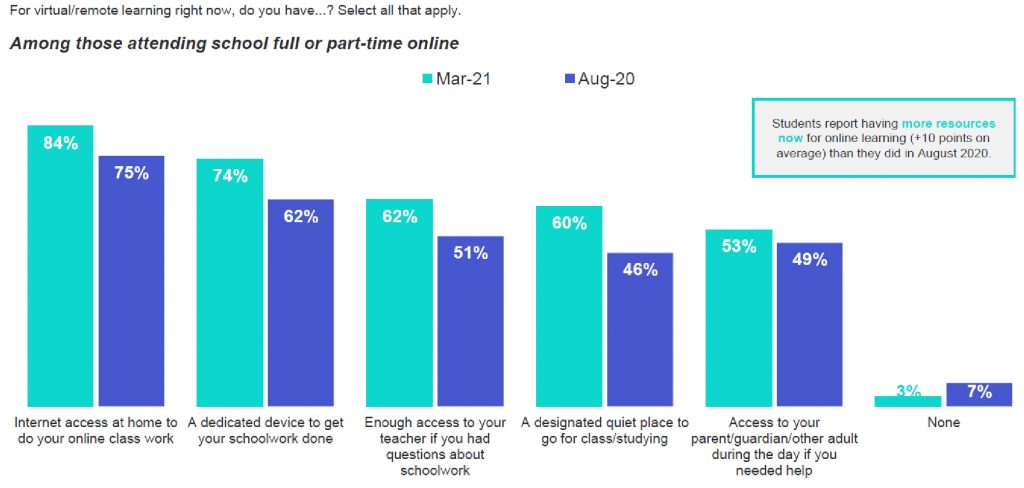
- Teens prefer a mix of in-person and online education more than spending five days a week in either location. Forty-four percent of teens say their ideal weekly education schedule would involve some days spent in-person and other days online, compared to 34 percent who say they would prefer entirely in-person and 21 percent preferring entirely online. Notably, parents are more likely to prefer entirely in-person education than teens, and teens are more likely to prefer completely online learning than parents.
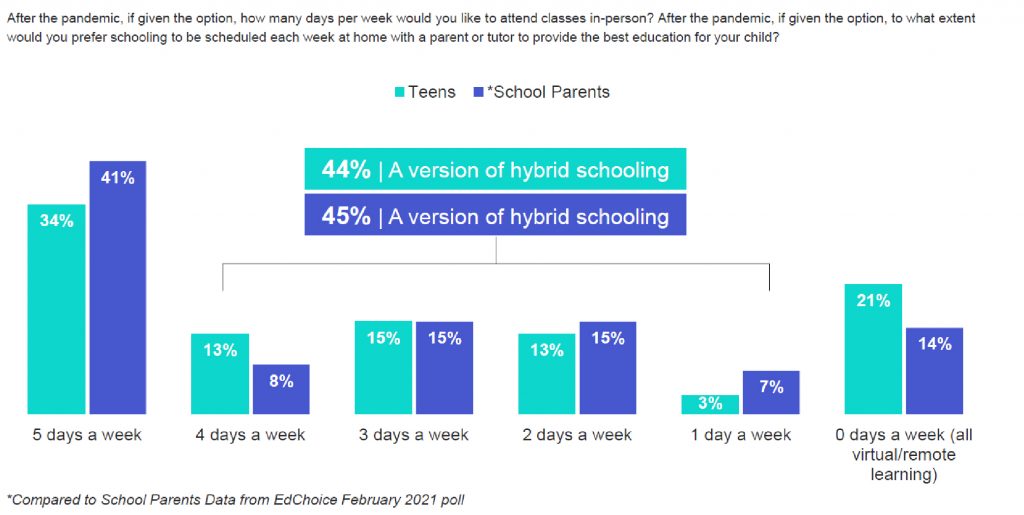
- Most teens say they are not familiar with education reform as a social issue. In a list of 13 current events, education reform was the second-least recognized among teens, with 40 percent saying they had read, seen, or heard something about the issue. Teens indicating at least some familiarity were slightly more likely to be low-income, white, and female.
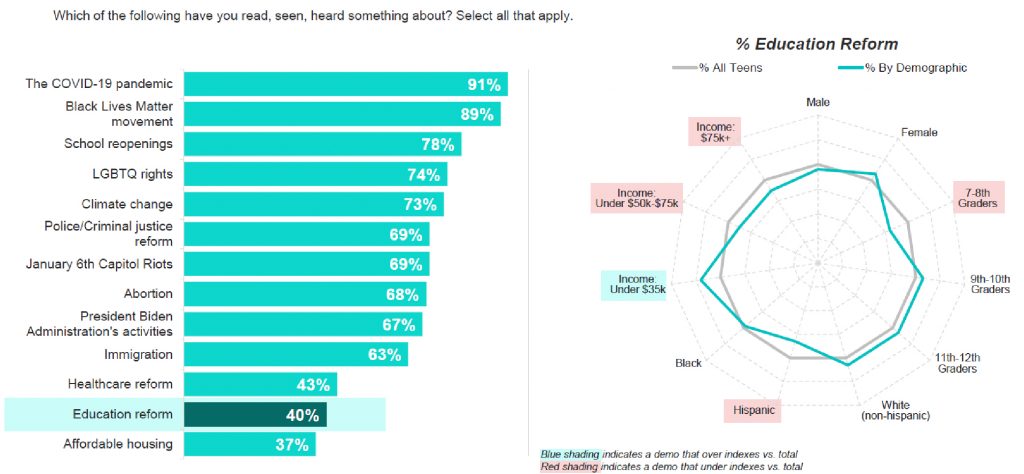
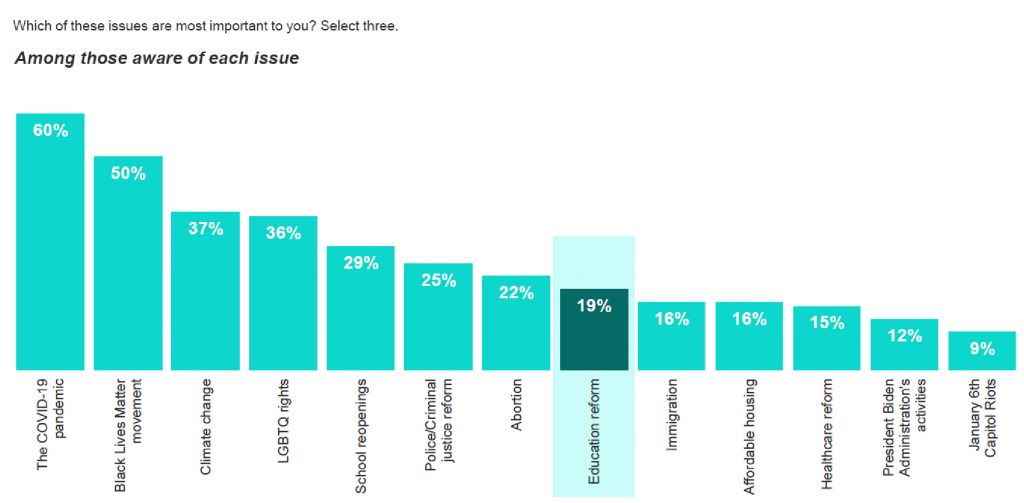
Check out the full report on the EdChoice Public Opinion Tracker.




